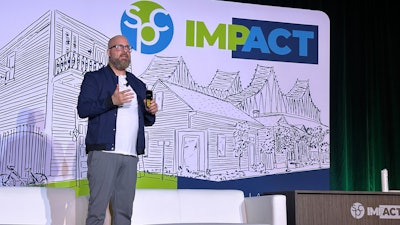
Intelligent alliance
 GreenBlue's Paul Nowak (left) and The Recycling Partnership's (TRP) Keefe Harrison.
GreenBlue's Paul Nowak (left) and The Recycling Partnership's (TRP) Keefe Harrison.
EPR, DEI and hackers, oh my
 From left, Sanjana Paul, Ezinne Okoro, and McKenna Morrigan
From left, Sanjana Paul, Ezinne Okoro, and McKenna Morrigan
"Cities got into the waste management business to protect public health and improve sanitation, not to deal with packaging." ... "Seattle is known as a city with a strong recycling program, and it's true. We have a long-standing and very successful recycling program. But most people don't know that its origin comes from a dollars and cents assessment, not a green ethos," Morrigan said today, highlighting the economic underpinnings required for circularity on her way to making the case for EPR.
Turn your single-use plastics into reusables with recyclable refill bottles
 Dr. Bronner's Karina Tettero.
Dr. Bronner's Karina Tettero.
LCAs don’t align with consumer perception
 The conclusion confirmed significant misalignment.
The conclusion confirmed significant misalignment.
Are consumer perceptions and LCAs aligned? You guessed it, not so much.
Clemson Department of Food, Nutrition & Packaging Sciences' (and frequent PW contributor) Andrew Hurley, PhD brought receipts at Impact today. The study recorded meal/granola bar LCAs of brands that use compostable plastic, compostable paper, store drop off PE/PE, and clear shiny PP/PP wrappers. Separately, it compared consumer sustainability perceptions of those materials. Specific results are in the study, but the conclusion confirmed significant misalignment.
Printpack's David McLain was above board that his company commissioned the study, but Hurly assured the audience he and his grad students were given full academic freedom.
PET’s future getting more sophisticated in its circularity
 From left, Andrew Jolin, Marija Massey, Jeff Snyder, Adam Gendell, and Mark Agerton.
From left, Andrew Jolin, Marija Massey, Jeff Snyder, Adam Gendell, and Mark Agerton.
More details will come soon, but The Recycling Partnership moderated as Procter & Gamble, Rumpke Waste & Recycling, Eastman, and Direct Pack, Inc. kicked things off addressing the evolving, and increasingly sophisticated PET circular value chain in the U.S. Demand isn't just for clear PET bales anymore, and brands like P&G and Mark Agerton's want that colored PET back for rPET haircare bottles. Meanwhile, sortation technology is far enough along to be able to distinguish between different PETs (including thermoforms), allowing for intra-PET sortation.
This should allow Rumpke's Jeff Snyder to start telling Midwestern consumers, 'yes, you can recycle those thermoforms.' And anything that can't be recycled mechanically at Rumpke now has an offtake market in Eastman now that the two have partnered. Molecular and mechanical recycling, working in concert, is nice to see. PW






















